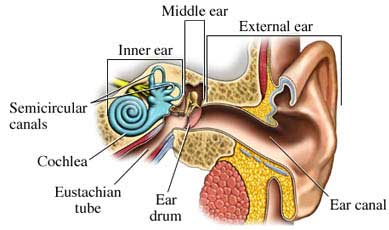By Barry Keate
Barry Keate, has lived with tinnitus over 40 years and has published 150+ research articles on numerous aspects of tinnitus. He is an expert on the condition and a well-known advocate for those with tinnitus.
For those of us with tinnitus and hearing loss, airplane travel creates considerable anxiety. Typical concerns include the likelihood that loud engine noise and air pressure changes will increase tinnitus and/or cause discomfort.
These are reasons for concern. However, with the proper planning prior to flight, individuals with tinnitus should have no serious worries and be able to fly without adverse consequences.
Engine Noise and Tinnitus
Most people are concerned that jet engine noise will damage their hearing and increase their tinnitus. Generally, engine noise is in the mid-frequency range while most people with tinnitus have hearing loss and tinnitus in the higher frequencies. While some high-frequency overtones associated with engine noise exist, there is usually little concern that the noise will further damage hearing in the tinnitus frequencies.
For those people with mid-frequency tinnitus sounds or those who are very sensitive to loud sound there may be more cause for concern. Anyone bothered by loud engine noise should try to sit in the forward part of the plane, in front of the wing. This is also in front of the engines and is considerably quieter than behind them.
The use of soft foam earplugs can also be helpful in reducing the sound level. These are very inexpensive and can be found in most grocery stores and pharmacies. The loudest part of any flight is during take-off and climbing to cruising altitude. Earplugs may be especially helpful then and most people can take them out once cruising altitude is reached.
There are also several very effective sound reducing headsets on the market that can also be used as headphones for listening to in-flight movies or music. These tend to be much more expensive than foam earplugs but provide years of external sound isolation and high quality acoustic reproduction. One system among many is the Bose QuietComfort 15 Acoustic Noise Cancelling Headphone.
The consistent use of hearing-related antioxidants, such as the Ginkgo biloba used in Arches Tinnitus Formula™ or N-Acetyl Cysteine (NAC), have been clinically proven to reduce hearing damage from loud sound and to offer protection to the hair cells in the inner ear.
Pressure Changes and Tinnitus
Pressure changes during flight present a much more difficult problem, even for those without tinnitus. In order to understand why, we must first address the issue of how and why our ears “pop.”
The cavity in the middle ear is behind the eardrum and outside the cochlea. This cavity is filled with air and must remain at the same air pressure as the outside air. The air in the middle ear is constantly being absorbed by its membranous lining. Air is then replenished through the Eustachian tube.

When swallowing or yawning, the Eustachian tube opens and air enters the middle ear. When outside air pressure changes, the eustachian tube supplies a bubble of air and the ears pop. When this happens, air pressure has been equalized.
If the Eustachian tube is blocked, ears will not pop and pressure cannot equalize. Eustachian tube blockage can occur for a number of reasons. The most common are head cold, sinus infections and nasal allergies. If this occurs, the air inside the middle ear is absorbed and replacement air cannot flow through the blocked Eustachian tube. This causes a vacuum inside the middle ear; the eardrum is sucked inward and stretched. Such an eardrum cannot vibrate naturally so sounds are muffled or blocked. In extreme cases, usually during rapid descent, the situation can become painful.
There are instances of blocked or partially blocked Eustachian tubes causing muffled hearing after long flights, especially trans-oceanic ones. This can be bothersome but is a temporary situation and does not indicate permanent hearing loss. The situation should clear after a few hours.
Swallowing activates the muscle that opens the Eustachian tube. Swallowing occurs more frequently when chewing gum or allowing mints to melt in the mouth. These are both good ways to unblock ears. Yawning is even better. Avoid sleeping during descent because swallowing doesn’t occur often enough to keep up with the pressure changes.
The Valsalva maneuver is another good way to clear the ears. Pinch the nose between finger and thumb and gently blow air down it with the mouth closed, but without releasing any air. The ears have been unblocked when you hear a pop.
Many experienced travelers use a decongestant pill or nasal spray an hour or so before descent. This will shrink the membranes and help the ears pop more easily. Travelers with allergies should take their medication at the beginning of the flight. Avoid making a habit of nasal sprays as after a few days usage they may cause more congestion than relief.
A product that reduces the rate of air pressure changes in the ear is available named EarPlanes. These are pressure regulating earplugs that reduce the degree of pressure changes and allow the ear to more gradually adapt to new pressure. They consist of a silicone earplug and a ceramic pressure regulator. The ceramic regulator allows outside air to pass through at a controlled rate, giving the ear more time to adapt. They are also very effective at reducing engine noise. EarPlanes can be found at major retailers such as Wal-Mart, Walgreens and Target.
Flying shouldn’t put those of us with tinnitus in a tail spin. With a little preparation and forethought sailing off into the wild blue yonder can be just the beginning of a great vacation. Bon voyage.
Get Free Shipping!
Order now and get free shipping on either the Tinnitus Starter Kit or Combo Pack. Try the doctor recommended products with clinically proven ingredients for tinnitus. No coupon code required.

